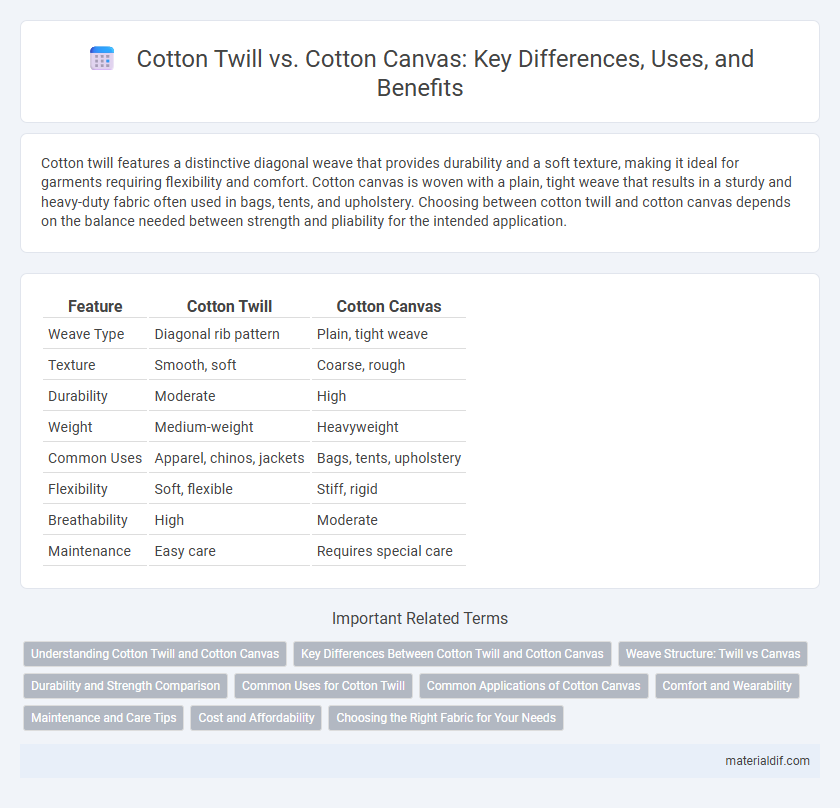Cotton twill features a distinctive diagonal weave that provides durability and a soft texture, making it ideal for garments requiring flexibility and comfort. Cotton canvas is woven with a plain, tight weave that results in a sturdy and heavy-duty fabric often used in bags, tents, and upholstery. Choosing between cotton twill and cotton canvas depends on the balance needed between strength and pliability for the intended application.
Table of Comparison
| Feature | Cotton Twill | Cotton Canvas |
|---|---|---|
| Weave Type | Diagonal rib pattern | Plain, tight weave |
| Texture | Smooth, soft | Coarse, rough |
| Durability | Moderate | High |
| Weight | Medium-weight | Heavyweight |
| Common Uses | Apparel, chinos, jackets | Bags, tents, upholstery |
| Flexibility | Soft, flexible | Stiff, rigid |
| Breathability | High | Moderate |
| Maintenance | Easy care | Requires special care |
Understanding Cotton Twill and Cotton Canvas
Cotton twill features a distinctive diagonal weave pattern that offers durability and a soft hand, making it ideal for garments like chinos and jackets. Cotton canvas, characterized by its plain weave and sturdy texture, provides exceptional strength and resistance, commonly used in bags, tents, and workwear. Understanding these differences helps in selecting the right cotton fabric based on the required durability, flexibility, and end-use application.
Key Differences Between Cotton Twill and Cotton Canvas
Cotton twill features a distinctive diagonal weave that provides durability and flexibility, making it ideal for garments like chinos and jackets. Cotton canvas has a plain, tightly woven structure that offers greater sturdiness and water resistance, often used for bags and outdoor gear. The key differences lie in their weave patterns, weight, and typical applications, with twill being softer and more pliable, while canvas is heavier and more rigid.
Weave Structure: Twill vs Canvas
Cotton twill features a diagonal weave pattern that creates a distinctive texture and enhances fabric durability, making it resistant to wrinkles and abrasion. Cotton canvas utilizes a plain weave structure characterized by a tight, crisscross pattern, providing high tensile strength and a rugged surface ideal for heavy-duty applications. The twill weave's diagonal ribs allow for more flexibility and drape, whereas the canvas's basket-like weave results in a stiffer and more rigid fabric.
Durability and Strength Comparison
Cotton twill features a diagonal weave that enhances its durability and flexibility, making it resistant to wear and tear under frequent use. Cotton canvas, with its denser and tighter plain weave, offers superior strength and rigidity, ideal for heavy-duty applications requiring maximum toughness. Both fabrics provide excellent durability, but cotton canvas typically outperforms cotton twill in strength due to its thicker thread count and tighter weave structure.
Common Uses for Cotton Twill
Cotton twill is commonly used in apparel such as chinos, denim jeans, and workwear due to its durability and distinctive diagonal weave pattern that provides flexibility and comfort. It is favored for crafting uniforms, jackets, and casual shirts where both strength and breathability are essential. Unlike cotton canvas, which is thicker and stiffer, twill's softer texture makes it ideal for clothing requiring a balance of resilience and ease of movement.
Common Applications of Cotton Canvas
Cotton canvas is a heavy-duty, tightly woven fabric commonly used for outdoor gear, backpacks, tents, and workwear due to its durability and water resistance. Its sturdy texture makes it ideal for upholstery, shoes, and sailcloth, providing longevity and protection in demanding conditions. Canvas's versatility in crafting painting surfaces and durable bags highlights its widespread application across creative and practical industries.
Comfort and Wearability
Cotton twill offers superior comfort and flexibility due to its diagonal weave, making it breathable and softer against the skin, ideal for everyday wear. Cotton canvas, with its denser and stiffer plain weave, provides durability and resistance to wear but tends to be less comfortable for prolonged use. The choice between cotton twill and cotton canvas ultimately depends on the balance needed between comfort and rugged wearability in garments or upholstery.
Maintenance and Care Tips
Cotton twill requires gentle machine washing on a cold setting to preserve its diagonal weave and minimize shrinkage, while cotton canvas benefits from occasional hand washing or spot cleaning to maintain its sturdy texture and prevent fabric warping. Both fabrics should be air-dried to avoid heat damage, with cotton canvas typically needing less frequent washing due to its durability and dirt resistance. Ironing cotton twill at a medium temperature helps retain its smooth finish, whereas cotton canvas often resists wrinkles, requiring minimal pressing during maintenance.
Cost and Affordability
Cotton twill generally costs less than cotton canvas due to its lighter weight and simpler weaving process, making it a more affordable choice for everyday apparel and casual wear. Cotton canvas, known for its heavy-duty durability and thicker texture, tends to be pricier, reflecting its suitability for workwear, bags, and upholstery. When budget is a primary concern, cotton twill offers a cost-effective option without sacrificing comfort and style.
Choosing the Right Fabric for Your Needs
Cotton twill offers a soft texture and distinctive diagonal weave, making it ideal for apparel like chinos and jackets that require durability with comfort. Cotton canvas features a heavier, tightly woven structure, perfect for heavy-duty applications such as bags, tents, and upholstery demanding maximum strength and resistance. Selecting between cotton twill and canvas depends on balancing softness and flexibility against toughness and longevity based on the specific project requirements.
Cotton Twill vs Cotton Canvas Infographic

 materialdif.com
materialdif.com